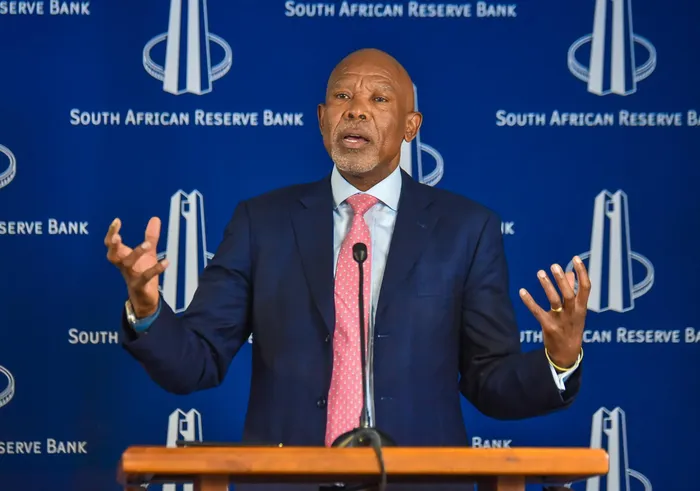South African Reserve Bank reduces repo rate by 25 basis points
INTEREST RATES

South African Reserve Bank Governor, Lesetja Kganyago announced on Thursday that the repurchase rate (repo rate) will decrease by 25 basis points (BPS).
Image: SARB | Facebook
South African Reserve Bank Governor, Lesetja Kganyago announced on Thursday that the repurchase rate (repo rate) will decrease by 25 basis points (BPS).
This comes after the Sarb's Monetary Policy Committee (MPC) met on Thursday, with consumer inflation rising to its highest level in more than a year.
This means that the repo rate will come down from 7.00% to 6.75% per annum, with the prime lending rate in the country coming down to 10.25%.
"The MPC decided to reduce the policy rate by 25 basis points, to 6.75%, with effect from 20 November. The decision was unanimous. Members agreed there was scope now to make the policy stance less restrictive, in the context of an improved inflation outlook," Kganyago said on Thursday.
"Because of these downside surprises, together with a stronger rand and a lower oil price assumption, we have small downward revisions to our inflation outlook, for both 2025 and 2026. We remain on track to deliver 3% inflation over the medium term," the Sarb governor said.
"It has been a turbulent year for the global economy. Trade patterns are shifting, but global growth is holding up better than expected. In the euro area, inflation appears contained. However, in other major economies, price dynamics are more challenging, with deflation risk in China, and inflation materially above 2% targets in the United Kingdom, Japan, and the United States," Kganyago said.
"In emerging markets, by contrast, inflation has eased. Indeed, 2025 has been better than expected for these countries. This is due to stronger capital flows and a weaker dollar, as well as favourable terms of trade," he said.
"Turning to South Africa, growth is looking steadier than last year. The outcome of the second quarter surprised on the upside and the third-quarter indicators are looking broadly positive. Our 2025 growth forecast has therefore been revised slightly higher, to 1.3%. We continue to see growth nearing 2% over the forecast horizon," Kganyago said.
"At the same time, investment has disappointed, falling further in the first half of the year. We expect an investment recovery in the second half. If this materialises it will be an encouraging signal that the economy is getting back to its historic growth trend. As it stands, growth is better, but not yet healthy. The risks to the growth outlook are assessed as balanced," he added.
Ahead of Kganyago's announcement, economists, analysts and consumers in the country were hopeful of a 25 basis point cut (BPS) to the repo rate.
Data from Statistics South Africa (Stats SA) on Wednesday showed that annual headline consumer inflation rate accelerated for the second month in a row to 3.6% in October, from 3.4% in September.
Though this inflation reading was below analysts' estimates of 3.7%, it was the highest inflation print since September 2024 when the rate was 3.8%.
Stats SA chief director of price statistics, Patrick Kelly, said the latest increase was driven largely by transport, recreation and culture, alcoholic beverages and tobacco, as well as housing, food and non-alcoholic beverages.
Recently, finance minister Enoch Godongwana endorsed a 3% inflation target with a tolerance band of 1 percentage point, thereby providing political support to the Sarb.
This adjustment replaces the previous target range of 3% to 6%, which had been maintained for the past 25 years.
On the new inflation target, the Sarb governor said, "As announced last week, we have moved away from the 3‒6% target range, which was established 25 years ago. The revised target, agreed between the Minister of Finance and myself as Governor of the South African Reserve Bank, is 3%, plus or minus 1 percentage point. As we move from a range target to a point target with a tolerance band, it is important to understand what the new target means. The tolerance band, of 1 percentage point either side of 3%, does not mean we will be indifferent to inflation anywhere between 2% and 4%. We want to be at 3%."
"However, no central bank has the tools to deliver inflation at an exact point all the time. As flexible inflation targeters, we also recognise that trying to offset all price shocks would create undesirable volatility in output. To support communication and accountability, we therefore want it understood that inflation will not always be precisely 3%. When there are deviations, we will explain what has driven inflation away from target, and we will do what is required to get back to target," Kganyago said.
"The MPC has long emphasised the need for macroeconomic and structural reforms to boost potential growth, achieve a sustainable debt path, and shift to a low-inflation regime. There has been significant progress on reform this year, as underscored by the recent credit rating upgrade from Standard & Poor’s, as well as South Africa’s exit from the Financial Action Task Force (FATF) grey list. The global environment nonetheless remains challenging, so it is urgent to sustain domestic reform efforts," Kganyago added.
Godongwana acknowledged the potential challenges involved, noting that the short-term fiscal costs such as reduced nominal GDP and slower revenue growth could complicate achieving fiscal objectives.
Nevertheless, he emphasized that the long-term benefits are expected to surpass these initial hurdles.
Watch the Sarb Governor's full address below: